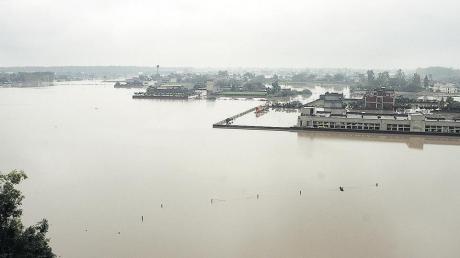 Scientists have argued that the “revived perennial condition of the Ghaggar, which can be correlated with the Saraswati, likely facilitated development of the early Harappan settlements along its banks.” – Aniruddha Ghosal
Scientists have argued that the “revived perennial condition of the Ghaggar, which can be correlated with the Saraswati, likely facilitated development of the early Harappan settlements along its banks.” – Aniruddha Ghosal
With “unequivocal evidence” that the Ghaggar river, where the early Harappans built their settlements, was perennial, a recent study has argued that this is the river that later came to be known as the Saraswati.
The hypothesis that modern-day Ghaggar-Hakra river system, which flows intermittently between India and Pakistan, could be the River Saraswati that finds mention in the Rig Veda has been reiterated several times since the 19th century. However, with no proof of the river’s uninterrupted flow during the zenith of the civilisation, it has been argued that the Harappans depended on monsoonal rains.
In the study, published in the journal Scientific Reports on November 20, scientists from the Physical Research Laboratory at Ahmedabad and the Department of Earth Sciences, IIT Bombay presented what they called was “unequivocal evidence for the Ghaggar’s perennial past by studying temporal changes of sediment provenance along a 300 km stretch of the river basin”.
They argued that “this revived perennial condition of the Ghaggar, which can be correlated with the Saraswati, likely facilitated development of the early Harappan settlements along its banks.”
The study argues that “Harappans built their early settlements along a stronger phase of the river Ghaggar”, during a period 9,000 to 4,500 years ago, “which would later be known as the Saraswati”, but “by the time the civilisation matured, the river had already lost its glacial connection.”
The study notes that while the eventual “decline” of the “civilisation” at the Ghaggar-Saraswati valley postdates “the exceptional changes to the flow of the river”, “a stronger perennial phase appears to have helped the early societies sow the seeds of the earliest known civilisation of the Indian subcontinent.”
The presence of a large number of Harappan settlements along the banks of the modern-day Ghaggar Hakra stream, which had remained monsoon-fed for most of its history, has baffled archaeologists since the 1950s. The authors noted that the observation that “Harappans in the Ghaggar valley made little effort to harvest rainwater, unlike their counterparts in the semi-arid Saurashtra and Rann of Kachchh regions” in spite of a weakening monsoon raised “serious doubt about the conclusion that the Ghaggar had seasonal water supply.”
The researchers noted that two of its largest cities, Mohenjo-daro and Harappa, along with smaller settlements were built along the “mighty and frequently flooding Indus and Ravi, respectively.”
In spite of evidence of an increase in localised rainfall for a few centuries, during the urbanisation of the period, the study notes, “The important question that needs to be asked is: what made the early settlers build their cities along a supposedly dying river instead of the well-watered plains of neighbouring perennial Himalayan rivers.”
The researchers studied the temporal changes in the origin of the sediment along the 300 kilometer stretch of the river basin and established that 80,000 to 20,000 years ago, the river was receiving sediments from the Higher Himalayas and 9,000 to 4,500 years ago, from the Lesser Himalayas. “The latter phase can be attributed to the reactivation of the river by the distributaries of the Sutlej,” it added.
The study scrutinised the dynamics of the Harappan civilisation and found that “timing of the rejuvenated perennial phase of the Ghaggar”, which was between 9,000 to 4,500 years ago, “coincides with that of the flourishing of the Pre-Harappan and Early Harappan cultures along its banks.”
“Towards the end of the Mature Harappan phase (4.6-3.9 ka), there is a clear evidence of human migrations to the lower and upper reaches of the river, leaving the middle part sparsely populated … which could be attributed to the disorganisation of the river as established in this work,” it said, while adding that the lower reaches of the river “possibly remained perennial, through a connection from the Sutlej, supporting mature and post-urban Harappan settlements.” – News18, 24 November 2019
› Aniruddha Ghosal writes on politics, environment, health and science for News18 at New Delhi.
Filed under: india, pakistan | Tagged: ghaggra-hakra river, harappa, indus valley civilisation, saraswati river | Comments Off on Was the river flowing through Harappa the Saraswati? – Aniruddha Ghosal



























